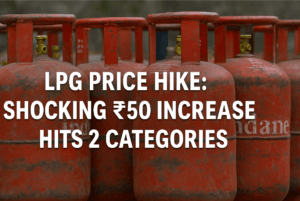LPG Price Hike: Shocking ₹50 Increase Hits 2 Categories – Massive Impact Revealed!
The price of domestic LPG cylinders has been increased by ₹50 for all consumers, including those under the Pradhan Mantri Ujjwala Yojana (PMUY) and regular households. This means PMUY beneficiaries will now pay ₹550 per cylinder, up from ₹500, while others will see prices rise from ₹803 to ₹853. The hike takes effect from April 8 and comes amid efforts to recover significant losses faced by oil marketing companies due to past subsidies. According to Petroleum Minister Hardeep Singh Puri, the move is necessary to help offset a ₹43,000 crore deficit.
He also mentioned that LPG prices are typically reviewed every two to three weeks. Despite the increase in domestic cylinder rates, there’s some relief for businesses as commercial LPG cylinder prices have been cut by ₹41. The new rate for a 19-kg commercial cylinder in Delhi is now ₹1,762. The minister also clarified that recent hikes in fuel duties are not aimed at burdening consumers but are part of a broader strategy to stabilize the energy sector.

LPG Price Hike: Shocking ₹50 Increase Hits 2 Categories – Massive Impact Revealed!
In a recent update affecting households across India, the government has announced a ₹50 price hike on domestic LPG (liquefied petroleum gas) cylinders, effective April 8. The decision, shared by Union Petroleum Minister Hardeep Singh Puri, impacts both subsidized and non-subsidized consumers. This adjustment aims to address financial challenges faced by oil companies while balancing the needs of consumers.
Revised Rates for Households
Under the Pradhan Mantri Ujjwala Yojana (PMUY), a flagship initiative providing subsidized LPG to low-income families, the cost per cylinder has risen from ₹500 to ₹550. For non-PMUY households, the price has increased from ₹803 to ₹853 per cylinder. This marks a significant shift for millions of families relying on LPG for daily cooking needs, particularly those in rural and economically weaker sections who benefit from PMUY.
Why the Price Hike?
Minister Puri clarified that the increase is part of a broader strategy to compensate oil marketing companies (OMCs) for losses incurred from selling LPG at subsidized rates. Over the past few years, these government-run companies have absorbed substantial financial strain to keep gas affordable for households. However, with global energy prices fluctuating and domestic subsidies creating a ₹43,000 crore deficit, the government has opted to gradually adjust prices to ease the burden on OMCs.
Puri emphasized that LPG prices are reviewed every 2–3 weeks to align with market conditions, ensuring transparency and responsiveness to economic trends. While the hike may seem sudden, it reflects ongoing efforts to stabilize the energy sector without abruptly disrupting household budgets.
A Silver Lining for Businesses
In contrast to the domestic hike, commercial users received some relief. The price of a 19-kg commercial LPG cylinder, commonly used by restaurants, hotels, and small industries, has been reduced by ₹41. In Delhi, the revised rate now stands at ₹1,762. This reduction follows a ₹6 increase implemented just a month earlier, highlighting the dynamic nature of pricing policies for commercial users. The move is expected to support businesses recovering from pandemic-related setbacks and rising operational costs.
Broader Context: Fuel Prices and Subsidies
The LPG price revision comes amid recent hikes in excise duties on petrol and diesel, sparking concerns about rising living costs. However, Puri reassured citizens that the government’s goal is not to overburden consumers but to create a sustainable framework for energy subsidies. The ₹43,000 crore loss linked to LPG subsidies underscores the delicate balance between keeping essential fuels affordable and maintaining the financial health of energy providers.
What This Means for Consumers
For PMUY beneficiaries, the ₹50 increase—though modest—could strain tight budgets, as many rely heavily on subsidies. Meanwhile, non-subsidized users, who typically belong to middle-income groups, will feel the pinch of an additional ₹50 per cylinder. The government has urged consumers to view the hike as a necessary step to ensure long-term stability in LPG supply and avoid abrupt, larger increases in the future.
Looking Ahead
The Petroleum Ministry has hinted at continued vigilance in monitoring global oil markets and domestic economic indicators to make timely adjustments. While further price revisions are possible, the focus remains on minimizing consumer impact while supporting OMCs. Authorities have also reaffirmed their commitment to the PMUY scheme, ensuring that subsidies remain intact for eligible families despite the incremental hike.
Conclusion
The LPG price hike reflects the government’s effort to navigate a complex energy landscape marked by volatile global prices and rising domestic demand. By incrementally shifting costs onto consumers, policymakers aim to sustain subsidy programs without collapsing the financial backbone of oil companies. For now, households and businesses alike must adapt to these changes, hoping for stability in the months ahead. The reduction in commercial cylinder prices offers a glimmer of relief, suggesting that the government is cautiously balancing diverse needs across sectors. As Minister Puri stated, the path forward will prioritize “equity and sustainability” in India’s energy journey.
You must be logged in to post a comment.